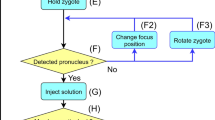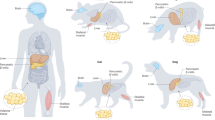Abstract
Tribromoethanol (TBE) is easy and inexpensive to make in the laboratory from readily available reagents, requires no special equipment for its administration, and is not subject to federal or state drug enforcement agency regulations. Intraperitoneal (i.p.) injection of TBE results in the simple and rapid induction of short-term surgical anesthesia; however, recent adverse reports about the efficacy and safety of TBE make its continued routine use as a rodent anesthetic controversial. The authors review the history and use of TBE as an animal anesthetic and conclude that TBE should be relegated to acute terminal studies when administered i.p.
This is a preview of subscription content, access via your institution
Access options
Subscribe to this journal
We are sorry, but there is no personal subscription option available for your country.
Buy this article
- Purchase on Springer Link
- Instant access to full article PDF
Prices may be subject to local taxes which are calculated during checkout

Similar content being viewed by others
References
Smithcors, J.F. in Textbook of Veterinary Anesthesia (ed. Soma, L.R.) 14 (Williams and Wilkins, Baltimore, 1971).
[No authors listed]. Fifty-eight years ago in Anesthesia & Analgesia. B. Bolliger, K. Maddox: Experimental anesthesia with tri-bromethyl alcohol (Avertin) and sodium iso-amyl-ethyl-barbiturate (Amytal). Current Researches in Anesthesia and Analgesia: 1931; 10: 112–115. Anesth. Analg. 68(4), 540 (1989).
Reynolds, J.E.F. (ed.) Martindale: The Extra Pharmacopoeia 29th Edn. 760 (The Pharmaceutical Press, London, 1982).
Soma, L.R. in Textbook of Veterinary Anesthesia (ed. Soma, L.R.) 147 (Williams and Wilkins, Baltimore, 1971).
Green, C.J. in Laboratory Animal Handbook 8 (Laboratory Animals Ltd., London, 1979).
Fish, R.E. in Anesthesia and Analgesia in Laboratory Animals (eds. Kohn, D.F., Wixson, S.K., White, W.J. & Benson G.J.) 1–28 (Academic Press, San Diego, 1997).
Mosby, H.S. & Canter, D.E. The use of avertin in capturing wild turkeys and as an oral-basal anesthetic in other wild animals. Southwest Vet. 9, 132 (1956).
The Merck Index, 9th edn. 1234–1235 (Merck and Co., Rahway, NJ, 1976).
Hogan, B., Costantini, F. & Lacy, E. in Manipulating the Mouse Embryo. A Laboratory Manual 132; 137; 143; 271 (Cold Spring Harbor Laboratory, Cold Spring Harbor, NY, 1986).
Hogan B, Beddington R, Costantini F, Lacy E. Manipulating the Mouse Embryo (Cold Spring Harbor Laboratory, Cold Spring Harbor, NY, 1996).
Papaioannou, V.E. & Fox, J.G. Efficacy of tribromoethanol anesthesia in mice. Lab. Anim. Sci. 43(2), 189–92 (1993).
British Veterinary Association Animal Welfare Foundation/Fund for the Replacement of Animals in Medical Experiments/Royal Society for the Prevention of Cruelty to Animals/Universities Federation for Animal Welfare). Refinement and reduction in production of genetically modified mice. Sixth Report of the BVAAWF/FRAME/RSPCA/UFAW Joint Working Group on Refinement. Anaesthesia, analgesia and perioperative care. Lab. Anim. 37(Suppl. 1), 17–20 (2003).
Silverman, J. Protocol Review. Anesthetics in GEM: does TBE make the grade? Lab Anim. (NY) 32(2), 19–21 (2003).
Norris, M.L. & Turner, W.D. An evaluation of tribromoethanol (TBE) as an anaesthetic agent in the Mongolian gerbil (Meriones unguiculatus). Lab. Anim. 17(4), 324–329 (1983).
Goelz, M.F. Anesthetic and pathologic effects of tribromoethanol in mice. Toxicology Bibliographic Information (Toxline), Document Number CRISP/95/S22112-02 (1994). http://toxnet.nlm.nih.gov.
Zeller, W., Meier, G., Burki, K. & Panoussis, B. Adverse effects of tribromoethanol as used in the production of transgenic mice. Lab. Anim. 32(4), 407–413 (1998).
Buetow, B.S., Chen, L.I., Maggio-Price, L. & Swisshelm, K. Peritonitis in nude mice in a xenograft study. Contemp. Top. Lab. Anim. Sci. 38(6), 47–49 (1999).
Reid, W.C., Carmichael, K.P., Srinivas, S. & Bryant, J.L. Pathologic changes associated with use of tribromoethanol (avertin) in the Sprague Dawley rat. Lab. Anim. Sci. 49(6), 665–667 (1999).
Lieggi, C. et al. Efficacy and safety of stored and newly prepared tribromoethanol in ICR mice. Contemp. Top. Lab. Anim. Sci. 44(1), 17–22 (2005)
Tarin, D. & Sturdee, A. Surgical anaesthesia of mice: evaluation of tribromo-ethanol, ether, halothane and methoxyflurane and development of a reliable technique. Lab. Anim. 6(1), 79–84 (1972).
Kaufman, M.H. Effect of anaesthesia on the outcome of pregnancy in female mice. J. Reprod. Fertil. 49(1), 167–168 (1977).
Kaufman, M.H. Parthenogenetic activation of mouse oocytes following avertin anaesthesia. J. Embryol. Exp. Morphol. 33(4), 941–946 (1975).
Silverman, J. & Muir, W.W. A review of laboratory animal anesthesia with chloral hydrate and chloralose. Lab. Anim. Sci. 43(3), 210–216 (1993).
Flecknell, P.A. Laboratory Animal Anaesthesia, 2nd edn. (Academic Press, London, 1996).
Wixson, S.K. & Smiler, K.L. in Anesthesia and Analgesia in Laboratory Animals (eds. Kohn, D.F., Wixson, S.K., White, W.J. & Benson G.J.) 165–203 (Academic Press, San Diego, 1997).
Lieggi, C. et al. An evaluation of preparation methods and storage conditions of tribromoethanol. Contemp. Top. Lab. Anim. Sci. 44(1), 11–16 (2005).
Weiss, J. & Zimmermann, F. Tribromoethanol (Avertin) as an anaesthetic in mice. Lab. Anim. 33(2), 192–193 (1999).
Meyer, R.E., Braun, R.D. & Dewhirst, M.W. in Tumor Models in Cancer Research (ed. Teicher, B.A.) 407–431 (Humana Press, Totowa, NJ, 2002).
Koizumi, T., Maeda, H. & Hioki, K. Sleep-time variation for ethanol and the hypnotic drugs tribromoethanol, urethane, pentobarbital, and propofol within outbred ICR mice. Exp. Anim. 51(2), 119–124 (2002).
Gardner, D.J., Davis, J.A., Weina, P.J. & Theune, B. Comparison of tribromoethanol, ketamine/acetylpromazine, Telazol/xylazine, pentobarbital, and methoxyflurane anesthesia in HSD:ICR mice. Lab. Anim. Sci. 45(2), 199–204 (1995).
Avila, M.Y., Carre, D.A., Stone, R.A. & Civan, M.M. Reliable measurement of mouse intraocular pressure by a servo-null micropipette system. Invest. Ophthalmol. Vis. Sci. 42(8), 1841–1846 (2001).
Smiler, K.L., Stein, S., Hrapkiewicz, K.L. & Hiben, J.R. Tissue response to intramuscular and intraperitoneal injections of ketamine and xylazine in rats. Lab. Anim. Sci. 40(1), 60–64 (1990).
Bagis, H., Odaman Mercan, H., & Dinnyes, A. Exposure to warmer postoperative temperature reduces hypothermia caused by anaesthesia and significantly increases the implantation rate of transferred embryos in the mouse. Lab. Anim. 38(1), 50–54 (2004).
Hart, C.Y., Burnett, J.C. Jr. & Redfield, M.M. Effects of avertin versus xylazine-ketamine anesthesia on cardiac function in normal mice. Am. J. Physiol. Heart Circ. Physiol. 281(5), H1938–H19345 (2001).
Roth, D.M., Swaney, J.S., Dalton, N.D., Gilpin, E.A. & Ross, J., Jr. Impact of anesthesia on cardiac function during echocardiography in mice. Am. J. Physiol. Heart Circ. Physiol. 282(6), H2134–H2140 (2002).
Gopalan, C., Hegade, G.M., Bay, T.N., Brown, S.R. & Talcott, M.R. Tribromoethanol-medetomidine combination provides a safe and reversible anesthetic effect in Sprague-Dawley rats. Contemp. Top. Lab. Anim. Sci. 44(1), 7–10 (2005).
Smith, J.C., Corbin, T.J., McCabe, J.G. & Bolon, B. Isoflurane with morphine is a suitable anaesthetic regimen for embryo transfer in the production of transgenic rats. Lab Anim. 38(1), 38–43 (2004).
Meyer, R.E. Anesthesia hazards to animal workers. Occup. Med. 14(2), 225–234 (1999).
Author information
Authors and Affiliations
Corresponding author
Ethics declarations
Competing interests
The authors declare no competing financial interests.
Rights and permissions
About this article
Cite this article
Meyer, R., Fish, R. A review of tribromoethanol anesthesia for production of genetically engineered mice and rats. Lab Anim 34, 47–52 (2005). https://doi.org/10.1038/laban1105-47
Received:
Accepted:
Issue Date:
DOI: https://doi.org/10.1038/laban1105-47
This article is cited by
-
A review of standardized high-throughput cardiovascular phenotyping with a link to metabolism in mice
Mammalian Genome (2023)
-
Increasing the effectiveness of intracerebral injections in adult and neonatal mice: a neurosurgical point of view
Neuroscience Bulletin (2015)
-
Non-invasive in vivo measurement of cardiac output in C57BL/6 mice using high frequency transthoracic ultrasound: evaluation of gender and body weight effects
The International Journal of Cardiovascular Imaging (2014)
-
Neurotoxic lesions of the thalamic reuniens or mediodorsal nucleus in rats affect non-mnemonic aspects of watermaze learning
Brain Structure and Function (2009)



